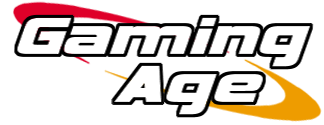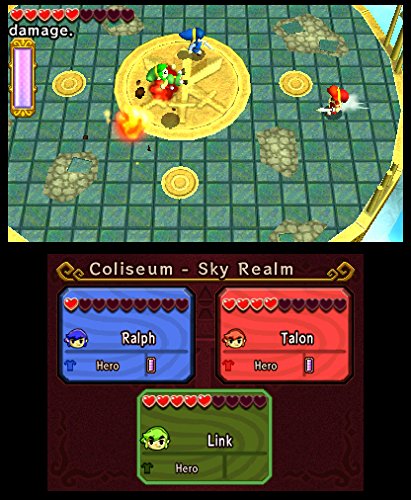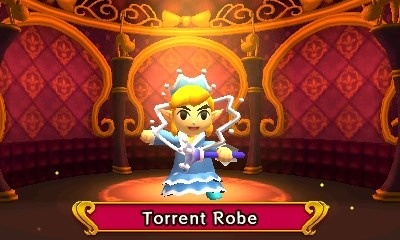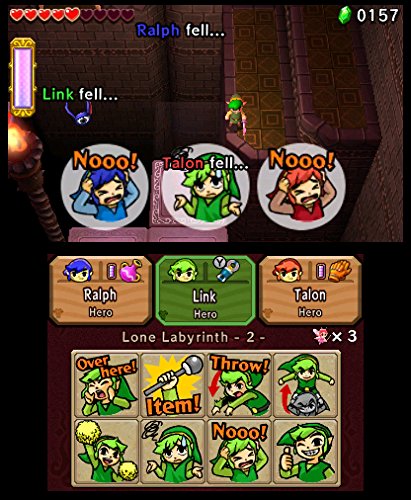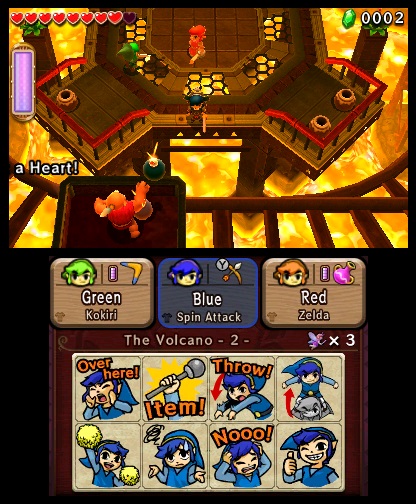Publisher: Nintendo
Developer: Nintendo EPD, Grezzo
Medium: Cartridge
Players: 1 or 3
Online: Yes
ESRB: E – Everyone
If there’s one thing I’ve always admired about Nintendo, it’s that they’re not afraid to move longstanding IP out of its comfort zone — even Zelda. In the case of Wind Waker’s bout of cel-shading, for instance, they even took fans along for the ride, but what’s even more noteworthy is that these drastic moves are almost always earned — rather than some publicity stunt. The Legend of Zelda: Tri Force Heroes isn’t on a time warp back into the Gamecube generation of paradigm shifts, but it is one of the more divergent in a long line of traditionally-structured adventures featuring Link.
You could easily start piecing together that Tri Force Heroes is a game focused more on the mechanics than a backstory and lengthy story arc, if only going by the front of the box, but the opening moments are quick to establish this as an actual goal. The plot is wacky right off the bat, introducing players to the fashion-oriented land of Hytopia and its recently despondent princess who’s been stripped of her wardrobe and flair by an evil witch — possibly to never again inspire citizens to pursue a life of fashion. Certainly, a hero should appear, and presumably defeat the witch to restore all things to their correct order.
As it just so happens, that’s exactly how things develop, and within a few minutes, the game has dropped you into the town square to get your bearings and start dungeon crawling. If Tri Force heroes has anything figured out, it’s that its players are likely to know what a Zelda game is, and even more likely to know how it’s played. The controls are simplified to accommodate a more action-arcade design (similar in mapping to A Link Between Worlds) and Nintendo is quick to use familiarity to our benefit. You won’t find any lengthy or deliberately idiot-proof tutorials in here — in fact, it’s almost the opposite.
The gameplay itself involves what could be approximated to questing in an MMO. Players have eight different worlds to choose from, composed of four different levels (and 4 stages within each level) in which they’ll be solving puzzles, vanquishing foes, and upon completion, each awarded with a material to use in crafting new outfits. This material distribution is between three chests, with at least one containing a component different than the other two. Not to dismiss the importance of gathering Hytopian Silk at the end of a level, but you’ll need to play through at least a second time for the chance to snap up that Octorok Sucker you keep missing out on.
Luckily, the puzzles are well-designed, and dungeon runs usually last between 10-15 minutes per level. It’s engaging to play, and as well, to replay areas. This is supplemented by providing players with various challenges in completed worlds, such as fewer heart containers, or a time limit.
Collecting the proper materials can be used to build costumes, a thematic gimmick that in a chicken-or-the-egg fashion could be a result (or product) of the game’s fashion-oriented plot, but nonetheless grant abilities to the player. Certain outfits will either enhance items, abilities, or provide general buffs to the team. They’re also kind of cute, but mostly they’re costumes and fun to wear.
Whether or not you’ll end up playing the level you’re looking to clear, among other things, can depend on the other two people you’re playing it with. In fact, a lot can depend on two other players, considering that the entire game is designed around the scheme of three players are in the level at the same time.
The mandatory Tri Force Heroes co-op is no secret, and though we’ve only now addressed it in the review, there’s actually very little to say that couldn’t be guessed by this strict design philosophy. The short of it is that you’ll be playing with two other people locally or online, and if neither are an option, then the game gives you Doppels to lug around. Doppels, as their name suggest, are stand-ins for Link — creepy dummy versions that in single-player will be swapped between to fulfill the same tasks that three players would complete simultaneously. You’ll carry them around, warp between them, and need to hit the checkpoint with all in tow just as if they were other players. If it sounds like a racket, it is, but it’s also somehow easier to do it all yourself in some instances than to collaborate with players online via emoticons.
Interestingly, Nintendo made allowances for what the Doppels will and won’t be able to do, in that they don’t take damage when not in use, and that if Link is carrying any in totem-pole fashion, that the topmost Doppel can operate their special item or general attack while being driven around by the player controlling the bottom. I say this is interesting because it means that the developers made a decision to accommodate three or one players by way of mechanics, rather than to scale level design down to an intermediate two-player solution for a much more accessible range of multiplayer numbers. Who can say which approach required more work, and ideally something would be present to consider those playing alone or with just a second person, but that’s how the single-player Doppel solution turned out.
I personally found boss fights more engaging with other players, but puzzle solving to be more manageable on my own than with players over the internet. This touches on one other aspect, which is that I don’t know two other people nearby with a 3DS, or even a 2DS. This is a shame in general, but especially when taking into account that Tri Force Heroes supports local download play. It’s one of those great features by necessity that Tri Force heroes would suffer significantly for had it been omitted, but shows how tremendously committed Nintendo is to this being a game best played locally with two other friends.
In fact, had I played with two other friends (even online), the measure of fun I had would have been exponentially greater than how I managed to enjoy the game on my lonesome. Even the word “lonesome” seems heavier now after knowing what I’m missing out on, despite having only positive interactions with players online. In a stroke of remarkable irony, reviewing Tri Force Heroes succeeded most in making me feel not only as if I don’t have friends to play with, but that I have no friends at all and that an online community has always been a stand-in for a real-life social life.
I’m torn on Tri Force Heroes, because I really do enjoy its brevity and game design. The visuals pop, online play is surprisingly smooth and reliable (aside from a few disconnects on other players’ parts), and the music is energetic and catchy. Even the writing seems like it’s having fun, pegging Link for a hero based on his look (later played for laughs with a character featuring the 80’s design not fitting the part). Nearly everything in Tri Force Heroes is on vacation, and it’s great to see a Zelda game let its hair down. Ego takes a backseat and play is the primary goal.
On the other hand is the whole three-player thing. It’s wonderfully thoughtful with some very clever puzzles, even involving the players themselves as conduits and pawns in certain situations, but Nintendo is too strong in design to cheapen their Four Swords successor by not accommodating two players. It’s admirable that they’re committed to the three-player game plan, but in boldness they’ve left players with unwanted concessions. You’ll either be playing online, with local friends, or alone with Doppels — staring dumbly from the screen to remind you of what’s missing.
It’s a price to pay for sticking to their guns, but honestly, if games like Destiny can get away with subjecting players to hard limits without taking a beating, I don’t see why Nintendo isn’t allowed the same permission for what’s ultimately a rewarding experience. Nintendo deserves, if anything, some recognition for what Tri Force Heroes accomplishes when requirements are met.
